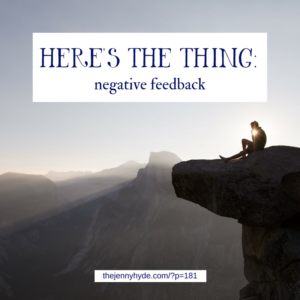 Every Friday I post a “here’s the thing” blog. “Here’s the thing” is something my mum (and many other wise people) like to say when they’re about to make a good point. Hopefully these posts are also good points.
Every Friday I post a “here’s the thing” blog. “Here’s the thing” is something my mum (and many other wise people) like to say when they’re about to make a good point. Hopefully these posts are also good points.
Getting feedback on products, orders, services, social media posts, photos and, y’know, everything is really important for businesses. Do customers like it? Does your mum like it? Is there anything that could be better? Why would they buy it? Why wouldn’t they buy it? Do they think it’s a 5 out of 10 or an 8 out of 10?
Knowing about people’s experiences can help you to streamline and develop your business for the better.
And when people love your stuff, it’s really, really uplifting. You remember what you’ve always known but sometimes forget: that this is what you love to do, what you’re meant to do, what you’ve worked really hard to be able to do.
Woohoo!
Negative feedback. Oh, the pain.
You worked really hard to create something that’s kind of part of you. You made it. It came from your brain, via your hands, into the world. And they don’t like it. They think it’s too expensive, or too flimsy, or too small, or it was delivered later than they expected. They don’t like the colour.
Or, as I heard from a friend recently, their boyfriend didn’t like the envelope. (Please, get a grip.)
And out of the thousands of customers who are happy, delighted, ecstatic or just quietly content (because that’s great too), you remember the handful of negative comments.
Why? And how do you get rid of it?
We’re genetically, evolutionarily* programmed to receive feedback and moderate behaviour based on it. We do it as kids, and it’s how we learn to read and write and exist with fellow human beings. You get corrected on your spelling, and you learn from it. You burp at the table, get told off, and you learn from it.
As a species, it’s really important that we please our tribe so they don’t throw us out on our own, where we’ll die via lions and tigers and bears (oh my!).
And when you’re a creative business, a solopreneur, that’s terrifying. You’ve built a tribe of customers who aren’t obligated to like you (they’re not your mum) and you’ve got them to buy something from you, and you get really excited about building this group of brilliant people who get you, get your craft, get your products and then… Damn. They don’t like it. They don’t like it as much as you want them to like it.
You worry. You worry that everyone will think the same as them. You equate one person’s opinion with eternal truth. You lose perspective. Your evolutionary brain is telling you to moderate your behaviour. Change everything about your business to please everyone. And it gets angry, because your safety is threatened. Or it breaks down and tries to hide from the truth, because fight or flight is a real thing that happens every day.
And I know. I’ve been there. In two months, I’ve had one person say something I’ve offered is too expensive. That’s one person versus the eight mentoring clients and 20+ other clients I’ve worked with, who are happy and grateful and value what I do. (Hi guys, love you.)
And it got me. I had to walk around the flat physically trying to shake the feeling off me. Had I missed the mark? Should I not have offered it? Was I barking up the wrong tree?
No. Perspective. A service that offers value and, well, service. 28+ clients. In two months. And the realisation that I can’t please everyone. And that I don’t want to.
So here’s the thing:
Negative feedback happens, especially as your business grows and you get more customers. Because a wider pool of customers means a higher risk of crazy people or people who don’t get it or people who value other stuff to you.
First step: Is it actually true? If the order to negative ratio is more than, say, 10%, you might need to consider whether you’ve got a quality issue or room-for-improvement value proposition. No biggie. Roll with it. Call me. You can deal with it.
Second step: Perspective. Opinion is not fact. One person’s preference for envelopes doesn’t make yours crap. One person’s ridiculously high expectation doesn’t mean you have to match it.
Third step: Get it out. Tell someone. Rant about it. Let it go. Write it down and set fire to it. Whatever it takes to get it out of your head.
It’s your job to put a great product out there, with a fair price, with clear expectations, and then deliver on it. It’s also your job to take constructive criticism and consider whether feedback would make your product and service better. It’s their job to understand the product, accept the limitations and nature of the product, and receive it.
It is not your job to succumb to every whim of every weirdo who didn’t get it.
As Brené Brown (there she is again) says, “Don’t try to win over the haters; you are not the jackass whisperer.”
*I wasn’t sure evolutionarily was a word, but it totally is and I learned something today.



Very well put Jenny! When you’ve lovingly made products you get attached to them and can really feel the brunt of a negative comment. Writing what you’d love to say but not actually sending it really does work as a way to let the comment go. It would be easy to get bogged down by one negative comment but we should learn from them, move on and centre on the positive comments instead. Actually, when it comes to pleasing people I like to take a tip from W.C.Fields. “If at first you don’t succeed, try, try again. Then quit. No use being a damn fool about it.”
I love that quote, Helen! And you’re right – writing it out but not sending it is a great way to diffuse your reaction.
Jenny you are a font of wisdom and sensibility. I do look forward to your posts every week!
Also: Haha Helen, I love that quote from W.C. Fields! Brilliant!
Mich x
Thank you Michelle! x
Why is it every post you do I feel like you are inside my head?! Thanks for this – and as one who is lucky enough to be working with you at the moment, your advice and copywriting skills are cheap at twice the price 🙂
Thank you very much, Jo! Very kind 🙂
Brilliant Jenny. Great advice as always 🙂 LOVE Brene Brown!
Mmmm, me too! I thought you might like her too 🙂
Thank you so much for this. I am soo guilty of this. Some times I just have a bad week with negative comments, orders going missing or breaking en-route and I sometimes question is it all worth it. But yes it is, but is hard not to lie awake at night sometimes. Thank you!
It’s really hard not to lie awake at night… but the key thing is that you still get up in the morning! I hope this post stays with you 🙂
I love this post. I’m going to print it out and put it on the studio wall. Hopefully if I read it often enough, it will start to sink in. Thanks Jenny x
Thanks Ali! I’m glad you found it helpful 🙂 x
I love ‘solopreneur’ and ‘jackass whisperer.’ I’m stealing them immediately. Thanks for the perspective, great advice/advise.
Hi Jenny, I haven’t seen your blog before – I came here via a Share on Facebook (the lovely Erica, of Pippin).
This is such a good article – some common sense and practical advice, in the midst of many panics, rants and negative posts on social media (for which read, mostly, FB groups…).
The tendency is to panic, when you get negative feedback. You are so right, that it’s important to keep it in perspective. I try to see all feedback as a learning opportunity – positive and negative. Yes, I certainly jump up and down and grin like an idiot, when someone writes lovely stuff about my lovely stuff… So far, I’ve been very lucky with feedback (and also with stuff like deliveries arriving on time), so there hasn’t been much that was negative. I hope that means my products (hand bound books) are good – the customers often tell me they are and I have had a few amazingly happy responses – but I do hope a customer would tell me first, if they were unhappy with something I made or did.
You can’t control others. You can’t “make” them like your stuff, or be happy with what you do. You can only do your best and sometimes, that doesn’t quite work.
So, when it goes wrong, it is so helpful to see things as you suggest. Perspective and common sense. So much to be said for these!
Thanks very much. I will be back!
Lizzie x
Hi Lizzie, lovely to have you here! It’s so easy to panic when you get negative feedback, because it taps into the core of our fears about our work. There’s so much to be said for a cup of tea, a bit of a think and some deep breaths! Looking forward to seeing you around these parts again! Jx
Hi Jenny, Just discovered your blog and it is so refreshing and honest. I have just started out on my own, running book making classes and I plan to sell some of the books I make. I will also print this as a reminder for days I might need a reminder or a lift. I’ll be visiting regularly, thank you.
Hi Sandie, welcome! So nice to have you here, and I look forward to hearing more about your new business.
Jenny, people are not jackasses, crazies, weirdoes or haters. They simply purchased a product and wrote a critique. GOOD or BAD. You make some excellent points about how to deal with negative feedback. However, your characterisations of people in this blog post are unprofessional. You have no filters.
Hi Jodi, I like what you’re saying here. I think you’re right to point out that people are people – whether they agree with you or not – and deserve respect for their review or critique. My characterisations in this particular post are intended to add some levity to a subject that can be very challenging for a lot of small business owners, including my clients. I respect my readers enough to recognise that they are caricatures, not judgements. Thank you for your take on this post! Jx
Great post yet again Jenny. I still check Feefo fanatically and breathe a sigh of relief every day I have positive feedback. I really should restrict myself to checking once a week! Initially all negative feedback hurts (sometimes A LOT) but if it’s constructive I have found it can be really helpful and improvements can be made. However, what negative reviewers perhaps don’t realise (or care) is that we will remember their comment, even if it’s completely unfair, long after they have forgotten about it and really did they want that and was it useful or necessary? Leave constructive and helpful feedback of course but otherwise, as my mother says, “If you can’t say anything nice please don’t say anything at all”.
Thanks, Jo. Not an easy thing to deal with at all! Reduce the fear to once a week – I recommend it!